Dirty Teeth and Bad Breath! Dental Disease in Pets
Dr Robbie Anderton BVSc (Hons) MANZCVS (Small Animal Medicine)
Did you know that the majority of pets we see in the clinic have some degree of dental disease?
But did you know that a lot of these pets are in pain, but are NOT SHOWING ANY SIGNS?
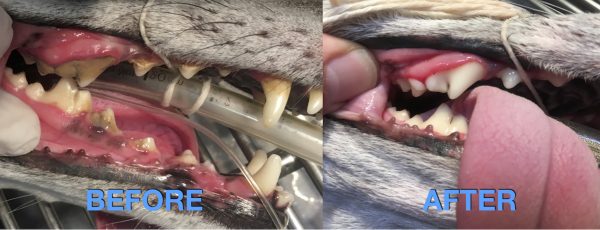
What is Dental Disease?
Dental disease occurs when there is Tartar (also known as Dental Calculus) on the surface of the teeth.
This causes the normally white, pearly coloured Enamel surface of the tooth be covered with a yellow to brown substance, which can be a thin layer, or can be really thick!
The thicker the tartar gets, and the closer it gets to the gum line, the easier it is for bacteria to get under the gums, leading to Gingivitis (or infection/inflammation of the gums).
Any amount of Gingivitis IS PAINFUL!
And the longer the gingivitis goes on for, the more the gums lift up, then more bacteria get under the gums and around the roots of the teeth, and the ligaments holding the teeth into the jaw start to loosen, leading to tooth root infections.
This can be REALLY PAINFUL TOO!
Also pets can have broken teeth as well, but they will still eat, despite the fact that there teeth are really sore.
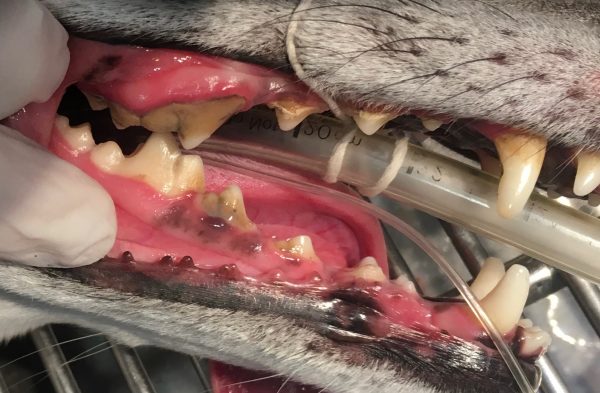
Can you see the brown discharge (Calculus) on the surface of the teeth, compared to the pearly white enamel on the bottom front tooth?
“My pet is still eating, so their teeth can’t be that sore”…
Pets will keep eating, regardless of how painful their teeth are, until the pain gets so bad that they would rather STARVE than eat.
If our teeth are sore, we will go and see someone to get it fixed, because we know why there is pain in our mouth, and know that something can be done about it.
Pets will just keep eating, despite being sore.
“How can I tell if my pet is in pain with their teeth?”
The easiest way to check if your pets teeth have dental disease – is to look!
If you lift up the lip of your dog or cat (don’t worry about looking at your chickens teeth, strangely, there have never been any reports of dental issues in chickens. This seems to be as rare as, wait – hang on a minute…).
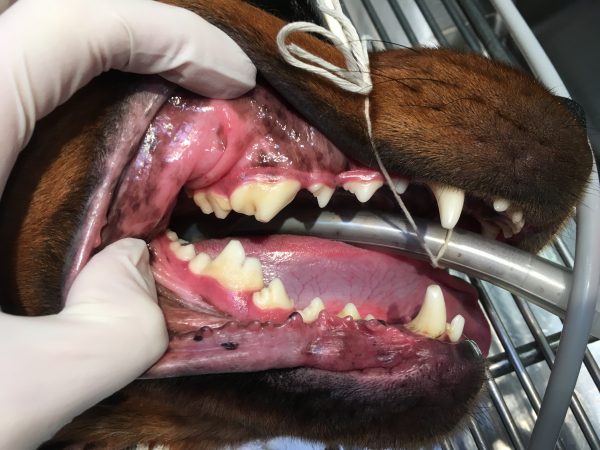
This dog’s teeth are pretty good -there is a very fine yellowing of the teeth which is a very thin amount of dental calculus forming, but there is no gingivitis
If you can see the pearly white enamel on all your pets teeth, and of the gums along the teeth are not red, then celebrate! Your pets teeth are fine!
If you lift up the lip of your pet, and there is a thin layer of brown or yellow over the surface of the teeth, or if there is a bit of redness or bleeding along the gum line against the teeth – your pet has early dental disease – get them checked out and get them treated, as THE TEETH WILL GET WORSE WITH TIME.
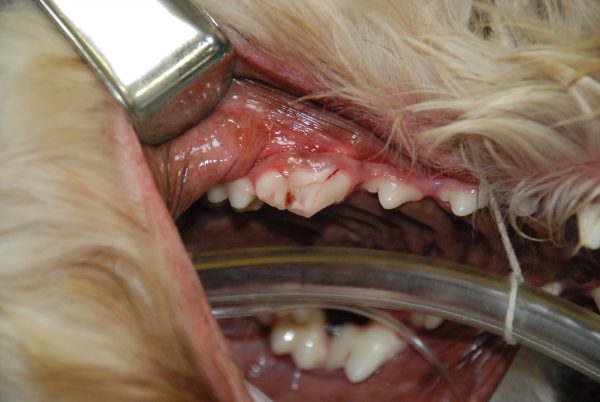
This dog had a broken tooth – you can see the flap of tooth that is still attached to the gum line, and the small amount of blood on the tooth as well.
If you lift up the lip of your pet, and the teeth are covered with a really thick, hard, brown to grey cover, the gums are red to purple, there’s bleeding, possibly even white discharge (which is pus!), and often with a horrible smell – Your pet has pretty serious dental disease, and will be in quite a bit of pain. You may also notice a broken tooth, with a crack in the surface, or a different shape to the other side.
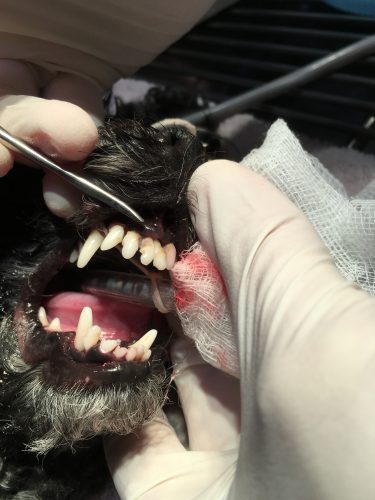
(This dog’s owner noticed she had bad breath. Closer examination revealed the front teeth (the incisors) had gum recession, loosening of the teeth, and infection. These teeth were removed.)
If your pet flat out won’t let you looking their mouth it may be because they are just so damn sore they won’t let you near it. Also if you can smell a pretty funky horrible smell coming from the mouth, then there is pretty major infection in there too.
“How do you treat dental disease?”
The good news is that we can treat dental disease, and if caught early enough, often control the progression so that your pet need not have any teeth removed.
Under a light general anaesthetic, we use an ultrasonic scaler to remove all the tartar and calculus off the teeth, also getting under the gums to remove any bacteria or calculus that may have formed under the gums.
Once we have cleared off the calculus, we can then make sure the teeth are healthy under the gums. If they are not, we will recommend having them removed, to stop them becoming reinfected and causing more pain down the track.
We use a polisher afterwards to help smooth the teeth over, from the scaler.
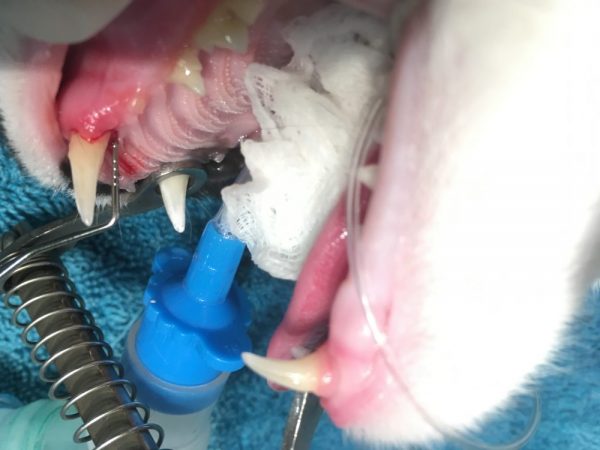
(This cats upper Canine Tooth had some mild gingivitis around the outside of the tooth, but under anaesthetic we were able to find marked pocketing of the tooth internally. This tooth was loose and was removed.)
“Will my pet be able to eat once teeth are removed?”
If your pet has been eating with painful teeth, they will eat even better with out them – as they won’t be in pain any more!
Dogs and cats with bad teeth generally only swallow their food, or only barely crack the food, because they have sore teeth.
When in doubt, check it out…
If you think your pet could have dental disease, get them checked out.
Call the clinic and get them booked in for the check.
Once we’ve seen them, we can give you an estimate for what you’d be looking at for the procedure to get them cleaned up, and whether we’d expect there to be any extractions.
If you think your pet could have dental disease, has smelly breath, or is painful around the mouth – get them booked in for a dental check now!
And – would you like to see what happens during a dental scale and polish?
Dr Robbie recorded his dog, Rosie, having her teeth cleaned a couple of months ago, check out this LINK!
Alternatively, if you want to book your pet in for a dental check – you can book HERE.